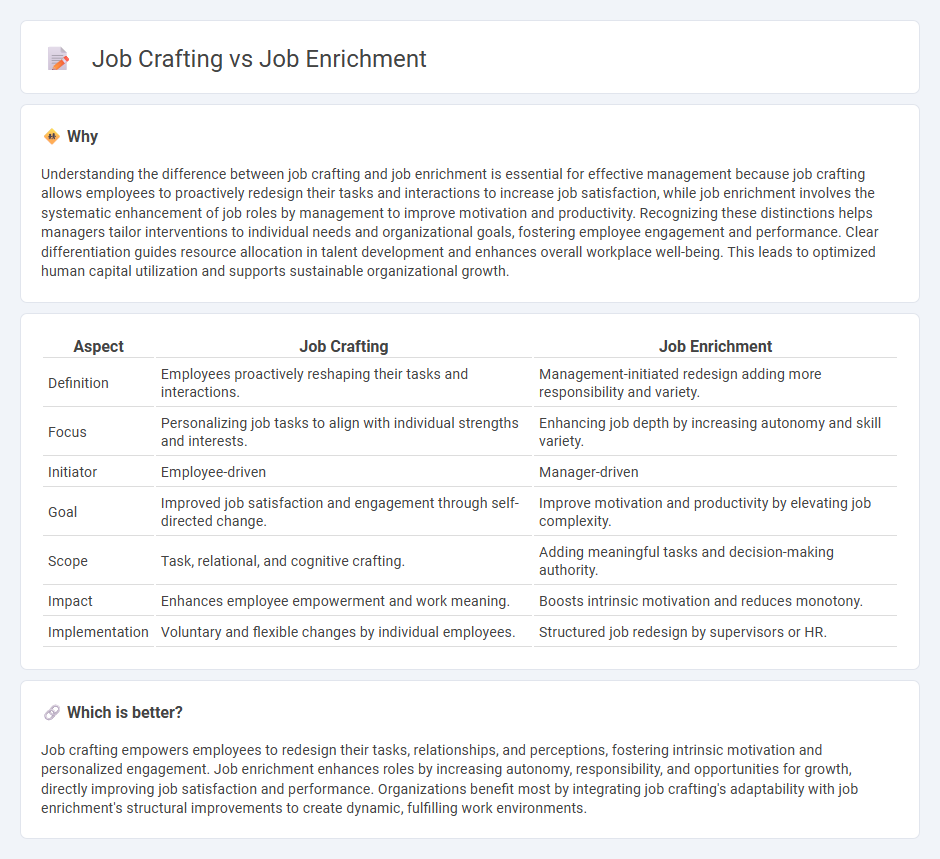
Job crafting empowers employees to redesign their tasks and relationships to better align with their strengths and interests, fostering increased engagement. Job enrichment enhances roles by adding higher-level responsibilities and autonomy, promoting motivation and job satisfaction. Explore these strategies to transform workplace dynamics effectively.
Why it is important
Understanding the difference between job crafting and job enrichment is essential for effective management because job crafting allows employees to proactively redesign their tasks and interactions to increase job satisfaction, while job enrichment involves the systematic enhancement of job roles by management to improve motivation and productivity. Recognizing these distinctions helps managers tailor interventions to individual needs and organizational goals, fostering employee engagement and performance. Clear differentiation guides resource allocation in talent development and enhances overall workplace well-being. This leads to optimized human capital utilization and supports sustainable organizational growth.
Comparison Table
| Aspect | Job Crafting | Job Enrichment |
|---|---|---|
| Definition | Employees proactively reshaping their tasks and interactions. | Management-initiated redesign adding more responsibility and variety. |
| Focus | Personalizing job tasks to align with individual strengths and interests. | Enhancing job depth by increasing autonomy and skill variety. |
| Initiator | Employee-driven | Manager-driven |
| Goal | Improved job satisfaction and engagement through self-directed change. | Improve motivation and productivity by elevating job complexity. |
| Scope | Task, relational, and cognitive crafting. | Adding meaningful tasks and decision-making authority. |
| Impact | Enhances employee empowerment and work meaning. | Boosts intrinsic motivation and reduces monotony. |
| Implementation | Voluntary and flexible changes by individual employees. | Structured job redesign by supervisors or HR. |
Which is better?
Job crafting empowers employees to redesign their tasks, relationships, and perceptions, fostering intrinsic motivation and personalized engagement. Job enrichment enhances roles by increasing autonomy, responsibility, and opportunities for growth, directly improving job satisfaction and performance. Organizations benefit most by integrating job crafting's adaptability with job enrichment's structural improvements to create dynamic, fulfilling work environments.
Connection
Job crafting and job enrichment are connected through their focus on enhancing employee engagement and job satisfaction by altering job roles. Job crafting allows employees to personalize tasks, relationships, and perceptions to better fit their strengths and interests, while job enrichment involves adding more meaningful responsibilities and autonomy to increase motivation. Both approaches contribute to improved performance and organizational commitment by aligning job characteristics with individual needs and preferences.
Key Terms
Task Variety
Job enrichment enhances task variety by redesigning roles to include a wider range of responsibilities, increasing employee motivation and satisfaction. Job crafting allows employees to personally tailor tasks and interactions, boosting engagement through autonomy and creativity. Explore how both approaches can improve workplace productivity and employee well-being.
Employee Autonomy
Employee autonomy in job enrichment involves organizational redesign to increase task variety, responsibility, and decision-making authority, enhancing motivation and satisfaction. Job crafting allows employees to proactively reshape their tasks, relationships, and cognitive perceptions to align their work with personal strengths and preferences. Explore how these strategies differently empower autonomy and impact engagement in modern workplaces.
Personalization
Job enrichment enhances roles by adding meaningful tasks and increasing autonomy, directly boosting employee motivation and satisfaction. Job crafting allows individuals to personalize their work by reshaping tasks, relationships, and perceptions to better align with their strengths and interests. Explore how these strategies uniquely impact personal and organizational growth.
Source and External Links
Job Enrichment: A Practical Guide + 13 Examples - Job enrichment involves adding motivators to existing roles to increase employee satisfaction and motivation by increasing skill variety, task significance, role broadening, and autonomy, such as combining tasks or creating natural work units to improve job ownership and productivity.
What is job enrichment? - Job enrichment is a motivational strategy focusing on making work more rewarding by increasing challenge, responsibility, autonomy, and opportunities for personal growth, ultimately enhancing employee engagement and satisfaction.
Q&A: What Is Job Enrichment? - It is a technique to increase employee workplace satisfaction by delegating additional responsibilities that offer new skills, motivation for advancement, a sense of accomplishment, and benefits employers by reducing turnover and absenteeism.
 dowidth.com
dowidth.com